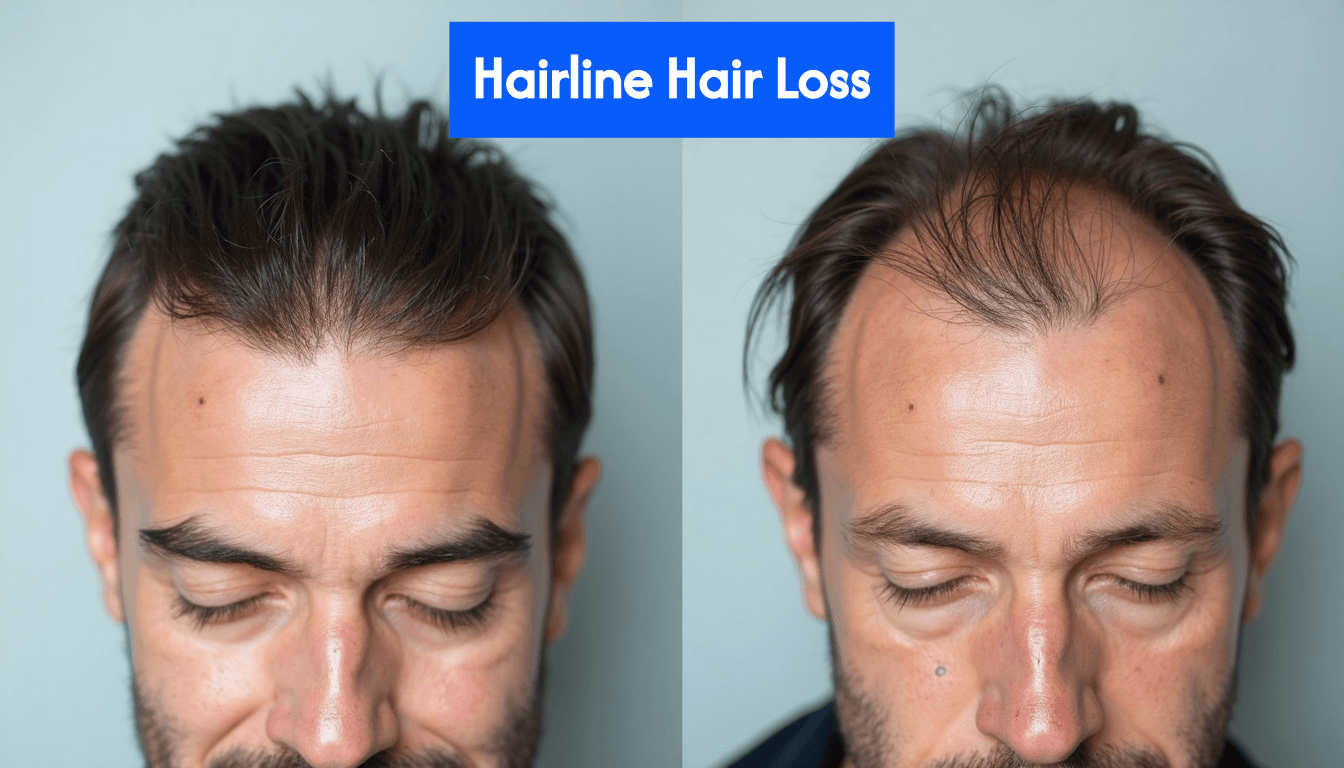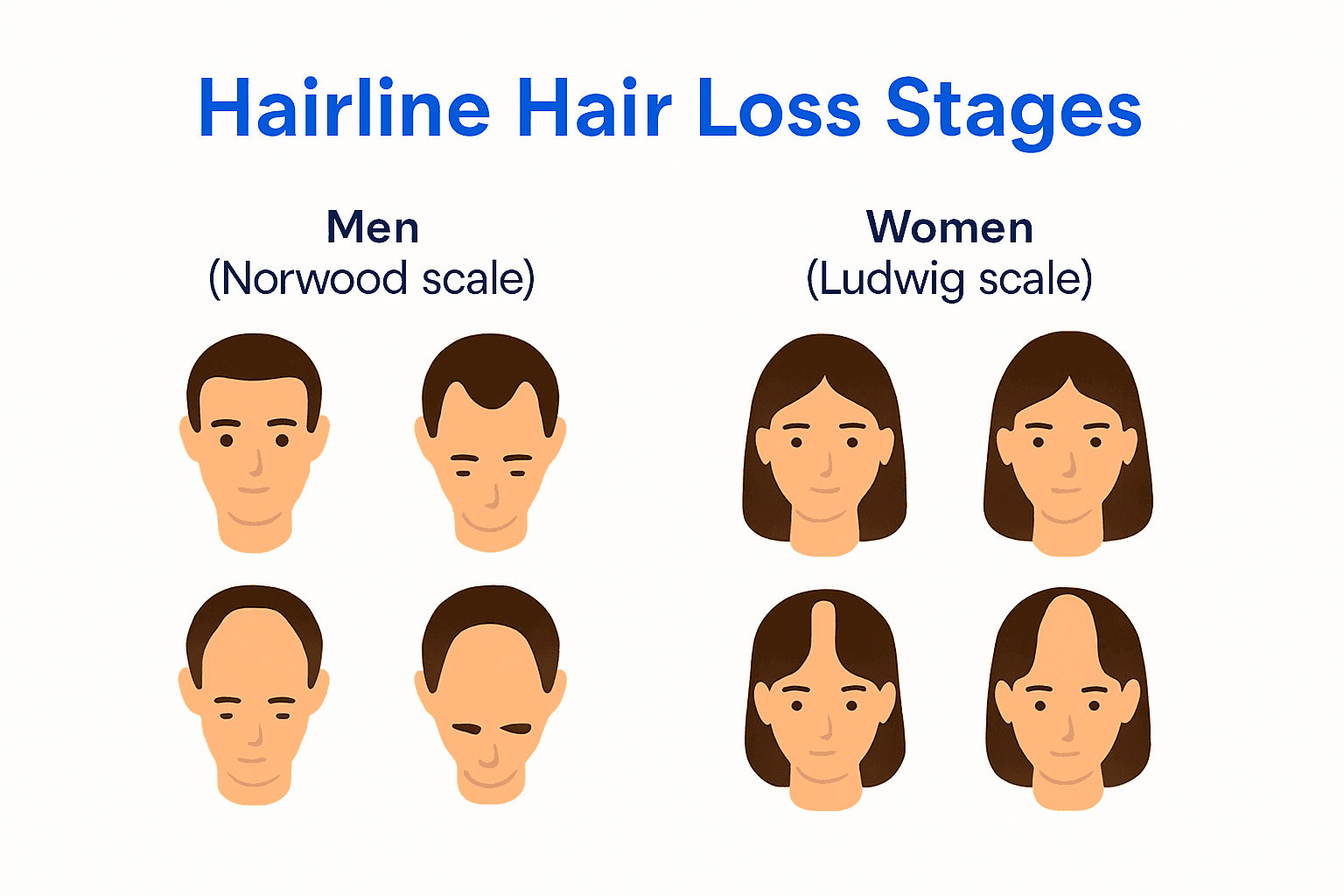Blog
Learning Materials
Understanding Hairline Hair Loss: Causes and Help
Updated: May 29, 2025

Hairline hair loss can feel overwhelming for many, affecting both men and women as they navigate their self-esteem and identity. Studies show that nearly 50 million men and 30 million women in the United States experience some degree of hair loss, making this a widespread concern. But here's the twist: the true game-changer lies not just in genetics or hormones. It's often the lifestyle choices that can dramatically influence hair health. This revelation sparks a path toward hope and proactive management for those facing this challenge.
Table of Contents
- What Causes Hairline Hair Loss?
- Recognizing Stages Of Hairline Thinning
- Help And Options For Hairline Loss
Quick Summary
| Takeaway | Explanation |
|---|---|
| Genetic Predisposition is Key | Hairline hair loss is primarily influenced by genetic factors, particularly androgenetic alopecia, which can lead to a greater likelihood of experiencing receding hairlines in individuals with a family history of hair loss. |
| Hormonal and Physiological Factors Matter | Hormonal changes, such as elevated cortisol levels and the effects of DHT, alongside medical conditions like thyroid disorders, significantly contribute to hairline thinning. |
| Lifestyle Choices Impact Hair Health | Poor nutrition, chronic stress, and environmental factors such as pollution can exacerbate hair loss; thus, addressing these lifestyle aspects can help manage hairline health. |
| Follow the Norwood-Hamilton Scale | Utilizing the Norwood-Hamilton scale allows individuals to systematically assess and monitor the stages of their hairline thinning, facilitating early intervention. |
| Explore Established and Advanced Treatments | FDA-approved treatments like minoxidil and finasteride, along with advanced options like PRP therapy and emerging research on stem cell therapies, provide various strategies for managing hair loss. |
What Causes Hairline Hair Loss?
Hairline hair loss is a complex condition affecting millions of men and women, with multiple underlying factors contributing to this challenging hair health issue. Understanding the root causes helps individuals develop targeted strategies for managing and potentially slowing down hair loss progression.
Genetic Predisposition: The Primary Culprit
Androgenetic alopecia, commonly known as male or female pattern baldness, stands as the most significant cause of hairline hair loss. This hereditary condition is fundamentally rooted in genetic inheritance patterns. Research from the National Institutes of Health reveals that individuals with a family history of hair loss are more likely to experience receding hairlines and bald spots.
Genetic factors influence how sensitive hair follicles are to dihydrotestosterone (DHT), a hormone derivative of testosterone. When hair follicles become increasingly sensitive to DHT, they progressively shrink, leading to thinner and shorter hair growth cycles. This genetic mechanism explains why hairline receding often follows similar patterns across family generations.
Hormonal and Physiological Triggers
Hormonal changes play a critical role in hairline hair loss beyond genetic predisposition. Mayo Clinic research highlights several key hormonal and physiological factors that contribute to hair loss:
- Testosterone Conversion: DHT's impact on hair follicles causes gradual miniaturization and eventual hair loss
- Aging Process: Natural hormonal shifts reduce hair growth efficiency
- Stress Hormones: Elevated cortisol levels can disrupt normal hair growth cycles
Additionally, medical conditions like thyroid disorders, autoimmune diseases, and hormonal imbalances can accelerate hairline recession. Conditions such as alopecia areata can cause sudden, patchy hair loss around the hairline, demonstrating the complex interplay between physiological health and hair growth.
Lifestyle and Environmental Factors
While genetics and hormones are primary drivers, lifestyle choices significantly impact hairline hair loss. Poor nutrition, chronic stress, certain medications, and environmental exposures can exacerbate hair loss progression. Dermatological studies indicate that nutritional deficiencies in iron, protein, and vitamins can compromise hair follicle health.
Prolonged exposure to environmental stressors like pollution, harsh chemical treatments, and excessive heat styling can weaken hair structure, making the hairline more susceptible to recession. Individuals experiencing early signs of hairline hair loss should consider comprehensive lifestyle assessments to identify potential contributing factors.
Understanding these multifaceted causes empowers individuals to take proactive steps in managing their hair health, whether through medical interventions, lifestyle modifications, or targeted hair care strategies.
Recognizing Stages of Hairline Thinning
Recognizing the progression of hairline thinning is crucial for early intervention and developing effective management strategies. Hair loss is not a sudden event but a gradual process with distinct stages that can be identified through careful observation and professional assessment.

The Norwood-Hamilton Scale: A Systematic Approach
Research from the Cleveland Clinic introduces the Norwood-Hamilton scale, a comprehensive classification system that meticulously tracks male pattern baldness progression. This scale identifies seven distinct stages of hairline recession, providing a standardized method for understanding hair loss patterns.
 In the early stages, individuals typically notice subtle changes: slight recession at the temples, often creating a more pronounced M-shaped hairline. As progression continues, the hairline begins to recede more dramatically, with thinning becoming more visible across the frontal and crown regions. Stage 4 represents a significant milestone, characterized by a substantially receded hairline and noticeable thinning at the vertex (crown).
In the early stages, individuals typically notice subtle changes: slight recession at the temples, often creating a more pronounced M-shaped hairline. As progression continues, the hairline begins to recede more dramatically, with thinning becoming more visible across the frontal and crown regions. Stage 4 represents a significant milestone, characterized by a substantially receded hairline and noticeable thinning at the vertex (crown).
Microscopic Changes in Hair Follicle Dynamics
International Society of Hair Restoration Surgery explains the underlying biological mechanisms of hairline thinning. Each hair loss stage is accompanied by critical microscopic changes in hair follicle structure and behavior. During early stages, hair follicles begin to miniaturize, producing progressively thinner and shorter hair strands.
This process, known as follicular miniaturization, occurs systematically:
- Initial Stage: Hair follicles gradually reduce in size
- Intermediate Stage: Hair growth cycles become shorter
- Advanced Stage: Follicles produce increasingly fine, weak hair strands
The transformation is not just visible externally but represents a fundamental change in hair growth mechanisms. Individuals might observe hair becoming progressively finer, less dense, and more prone to breakage before complete follicle dormancy.
Gender and Individual Variations in Hairline Thinning
While male pattern baldness follows more predictable patterns, hairline thinning exhibits significant individual variations. Dermatological research highlights that women experience different hairline thinning patterns compared to men, often characterized by diffuse thinning rather than complete recession.
Factors influencing individual hairline thinning include:
- Genetic predisposition
- Hormonal balance
- Age
- Overall health conditions
- Stress levels
- Nutritional status
Recognizing these stages early allows individuals to consult healthcare professionals, explore potential treatments, and develop personalized hair preservation strategies. Understanding that hairline thinning is a progressive condition empowers individuals to take proactive steps in managing their hair health before advanced stages of hair loss occur.
Help And Options For Hairline Loss
Navigating hairline hair loss involves understanding a comprehensive range of treatment options, from established medical interventions to emerging therapeutic approaches. Individuals experiencing hairline recession have multiple strategies to address and potentially manage their hair loss condition.
Established Medical Treatments
Cleveland Clinic research highlights two primary FDA-approved treatments for hairline hair loss: topical minoxidil and oral finasteride. Minoxidil, available over-the-counter, works by stimulating blood flow to hair follicles and extending the growth phase of hair cycles. Finasteride, a prescription medication, reduces dihydrotestosterone (DHT) levels, which can slow or halt hair loss progression.
These medications offer different mechanisms of action:
- Minoxidil: Topical solution promoting hair growth and follicle stimulation
- Finasteride: Oral medication blocking testosterone conversion to DHT
- Combined Approach: Often recommended for enhanced effectiveness
Patients typically observe initial results after 3-6 months of consistent treatment, with varying individual responses based on genetic factors and overall health conditions.
Advanced Therapeutic Interventions
Regenerative Medicine Research reveals promising emerging treatments for hairline hair loss. Platelet-rich plasma (PRP) injections represent an innovative approach, utilizing a patient's own blood components to stimulate hair follicle regeneration. Low-level laser therapy and microneedling have also demonstrated potential in clinical trials for improving hair density and promoting follicular health.
Cutting-edge interventions include:
- PRP Therapy: Concentrated platelet injections to stimulate hair growth
- Microneedling: Minimal invasive technique promoting collagen production
- Low-Level Laser Treatment: Non-invasive stimulation of follicular activity
Emerging Research and Future Possibilities
Columbia University Medical Center highlights groundbreaking research exploring innovative hair loss solutions. Emerging scientific approaches like JAK inhibitors and advanced stem cell therapies show remarkable potential for reactivating dormant hair follicles and potentially reversing hair loss.
These future treatments represent exciting possibilities:
- Stem Cell Therapies: Potential to regenerate hair follicles
- JAK Inhibitors: Molecular approach to stimulate hair growth
- Genetic Interventions: Targeted treatments addressing genetic hair loss factors
While no single solution guarantees complete hair restoration, combining medical treatments, lifestyle modifications, and staying informed about emerging technologies provides individuals with comprehensive strategies for managing hairline hair loss. Consulting dermatology specialists remains crucial for personalized treatment plans tailored to individual genetic, hormonal, and health profiles.
Frequently Asked Questions
What causes hairline hair loss?
Hairline hair loss is primarily caused by genetic factors, specifically androgenetic alopecia, along with hormonal changes, physiological triggers, and lifestyle choices such as poor nutrition and chronic stress.
How can I recognize the stages of hairline thinning?
You can recognize the stages of hairline thinning using the Norwood-Hamilton scale, which classifies male pattern baldness into seven stages, indicating the degree of hairline recession and thinning.
What treatments are available for hairline hair loss?
Established treatments include FDA-approved medications like minoxidil and finasteride. Advanced options such as PRP therapy, low-level laser therapy, and emerging therapies like stem cell treatments are also available.
How long does it take to see results from hair loss treatments?
Patients typically see initial results from topical minoxidil and oral finasteride within 3 to 6 months of consistent use. Individual responses may vary based on genetics and overall health.
Take Control of Your Hairline Today
Facing hairline hair loss can feel like an uphill battle, but you don’t have to fight alone! With nearly 50 million men and 30 million women in the U.S. experiencing this issue, understanding the genetic, hormonal, and lifestyle triggers that contribute to hair loss is just the first step. While recognizing these challenges is vital, actively addressing them is where the real change begins.

At MyHair.ai, we're dedicated to providing a tailored approach to your hair health. Our AI-based hair health analysis dives deep into your unique patterns, enabling you to track changes and understand what affects your hairline. With our personalized growth projections and tailored product recommendations, you're not just tracking hair loss—you're actively combatting it! So why wait? Start your journey to healthier hair today at https://myhair.ai and take the first step toward regaining your confidence. Your hair deserves this!